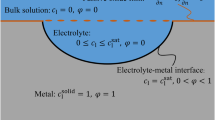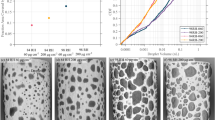Abstract
WE believe that a stochastic theory originally developed to explain the fracture of solid materials under stress can be used to explain pitting corrosion. In the past (see ref. 1), both pitting potential2 and induction time3 have been used to select resistant alloys and to search for possible breakdown mechanisms. Studies of these and other phenomena, however, always reveal a wide scatter of data, so we have used the stochastic approach, which has proved useful in understanding time-dependent phenomena (see refs 4 and 5).
This is a preview of subscription content, access via your institution
Access options
Subscribe to this journal
Receive 51 print issues and online access
$199.00 per year
only $3.90 per issue
Buy this article
- Purchase on Springer Link
- Instant access to full article PDF
Prices may be subject to local taxes which are calculated during checkout
Similar content being viewed by others
References
Szklarska-Smialowska, Z., Corrosion, 27, 223 (1971).
Leckie, H. P., and Uhlig, H. H., J. electrochem. Soc., 113, 1261 (1966).
Hoar, T. P., and Jacob, W. R., Nature, 216, 1299 (1967).
Hirata, M., Kikai no Kenkyu, 1, 231 (1949).
Yokobori, T., J. phys. Soc. Japan, 7, 44 (1952).
Sato, N., Nakagawa, T., Kudo, K., and Sakashita, M., Trans. Japan Inst. Metals, 13, 103 (1972).
Author information
Authors and Affiliations
Rights and permissions
About this article
Cite this article
SHIBATA, T., TAKEYAMA, T. Pitting corrosion as a stochastic process. Nature 260, 315–316 (1976). https://doi.org/10.1038/260315a0
Received:
Accepted:
Issue Date:
DOI: https://doi.org/10.1038/260315a0
This article is cited by
-
Feedback effect on pitting corrosion dynamics
Journal of Solid State Electrochemistry (2015)
-
Pitting behavior on super 13Cr stainless steel in 3.5% NaCl solution in the presence of acetic acid
Journal of Solid State Electrochemistry (2009)
-
Protection of beryllium metal against microbial influenced corrosion using silane self-assembled monolayers
Metallurgical and Materials Transactions A (1999)
-
Effect of pitting corrosion in NaCl solutions on the statistics of fracture of beryllium
Metallurgical and Materials Transactions A (1998)
-
Passivity breakdown and pitting corrosion of binary alloys
Nature (1991)
Comments
By submitting a comment you agree to abide by our Terms and Community Guidelines. If you find something abusive or that does not comply with our terms or guidelines please flag it as inappropriate.



